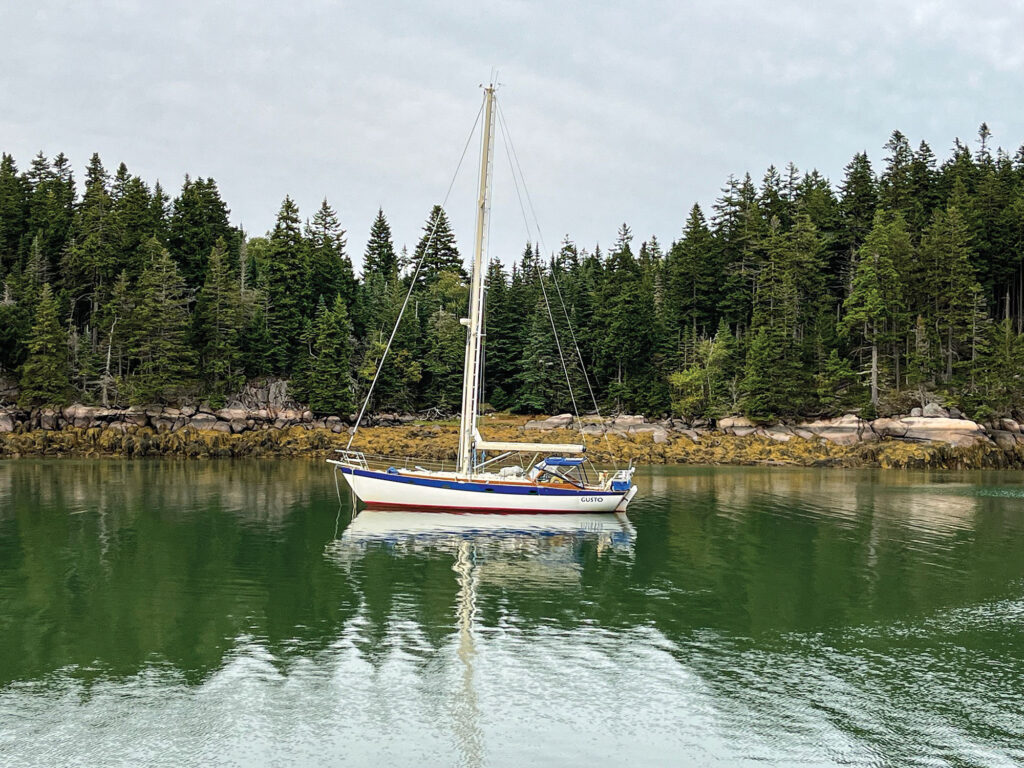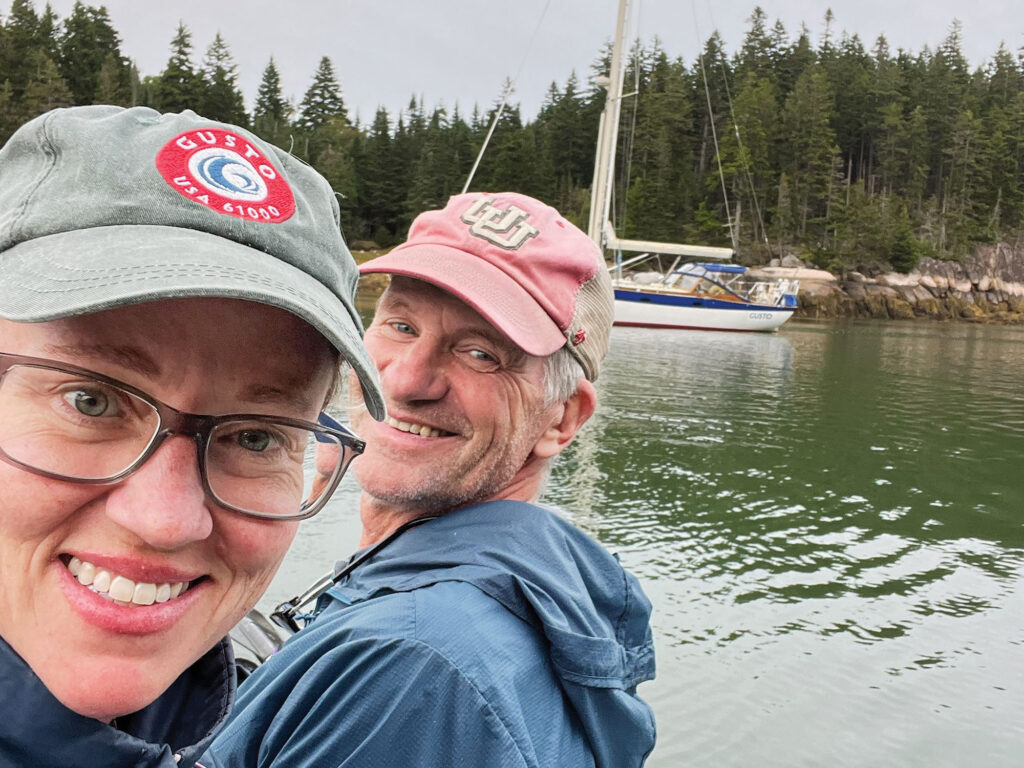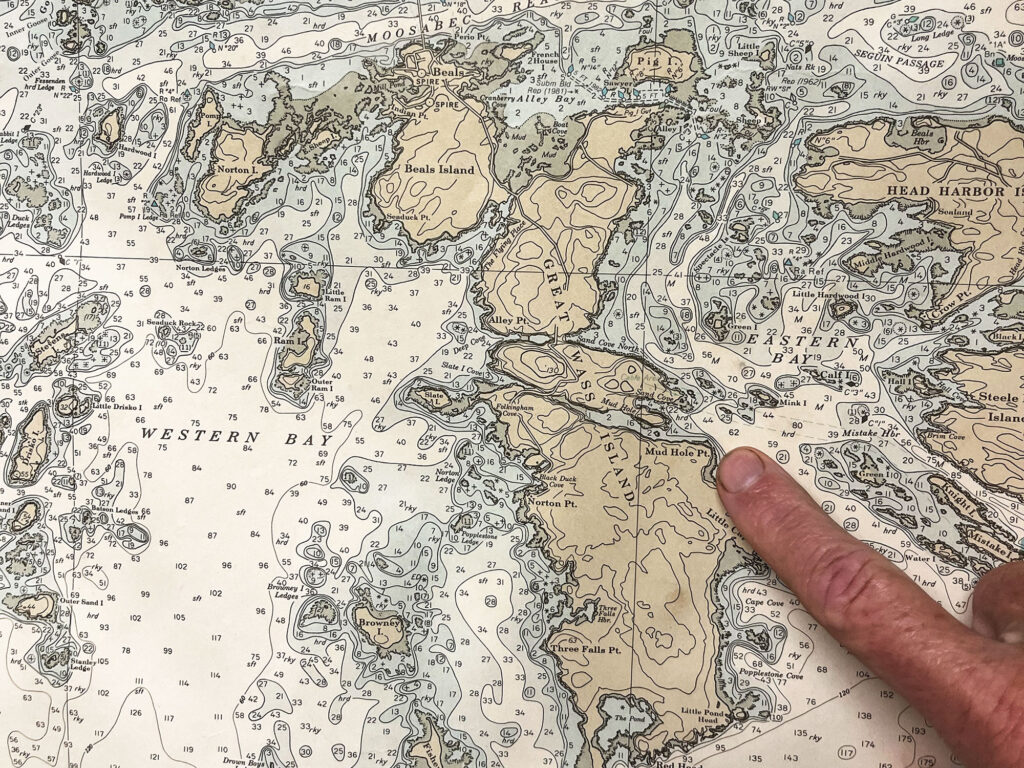
It was, in fact, dark and stormy on that night in September 2023. The sunset had been extraordinary, shining orange and pink on breakers pounding the headland of Great Wass Island in Beals, Maine. Spray leapt 20 feet into the darkening night until the lasting image was foamy fangs of white against the gloom.
Hurricane Lee had sent these waves as shock troops before the true impact. The wind was fitful at first, and then it steadied from the northeast. Our 43-foot cutter, Gusto, moved against its anchor, pulling slack and then settling into the center of the deep water.
Then it was full night. The clouds moved in. The only lights were our own.
When the storm hit, our initial experience was not through sight, but through the ears and the body. Our eyes were locked out by cloudy midnight and sheets of rain, but our ears magnified the creaking anchor rode. Our bodies felt the rattle of halyards and pounding rain on the deck.
As the big blast arrived and the first big tug on the anchor held, I was up the companionway. The spotlight showed trees raving wildly around, catching the wind and holding the worst gusts above us. The water was coated in pine needles and dust. This hurricane harbor was like a foxhole, and we were down there getting religion.
This was the first time that I had ever been on board in a place where the National Weather Service predicted a hurricane would hit. For most of us, hurricanes happen to other people. This one was about to hit me, my wife, Whitney, and our Gusto.
When a hurricane is headed in your direction, what decisions need to be made? Which ones do you absolutely need to get right? The first attempt at most anything is tricky, whether that’s changing the impeller or docking the boat.
The biggest lesson I learned from Hurricane Lee? The psychological challenges are as big as the physical ones.
At the Start
The National Hurricane Center advisory for September 13 was that Lee would remain a large and dangerous cyclone while it approached eastern New England and Atlantic Canada. Hurricane conditions and coastal flooding were possible in eastern Maine, southern New Brunswick and western Nova Scotia, and a Hurricane Watch was in effect.
It was an unusual advisory. Most years in Maine, these systems spin out to sea. Hurricane Lee made it personal by coming straight for us.
It wasn’t supposed to be this way. Lee was supposed to fade east, and we were supposed to enjoy Down East cruising from Roque Island to Eastport before coasting on to Nova Scotia.
Cell coverage is not what it could be on that bold coast, so, after a placid phone-free weekend, it was bracing to sail into cell service and see the phone light up with texts: “Look out!” “Plan for Lee?” “You might be in the bull’s-eye” “Pull the boat and move ashore!”
There was the bright-red pinwheel passing Bermuda and tracking by Cape Cod, Massachusetts, toward this cul de sac where Maine ends and Canada begins. This storm wasn’t blowing itself out to sea. It was blowing itself right up Gusto’s wake like a big, bad wolf on our scent.
Whitney and I sailed to nearby Jonesport to make our plan.
Today, you know that Hurricane Lee landed as a tropical storm, and that winds merely blew 60. In the pause preceding impact, we had only alerts and imaginations. For most cruisers, when the storm has passed, it is easy to assert a confident storm strategy. But the days before, while a sinister swell rocks the sea, we all feel ambivalence. I know that I did. At that time, those of us afloat between Schoodic Point and Cape Sable had three days to ponder just how violent our tropical visitor would be.
That interval interests me: the time between innocent summer cruising and the deadly named storm. Given how warm and stormy the Atlantic has become, we should all get better at this process of preparing for impact.
Into this countdown, every skipper packs weighty decisions that can’t be undone. Your choices about location or anchor or boatyard accumulate into a storm reckoning. You wrestle with uncertainty, hesitate to make definite decisions from indefinite information, strain your brain while sharing evolving ideas. I suppose I’m saying that storm preparation is physical and mental, and it’s worth acknowledging that the story of tying lines and setting anchors can look far too straightforward.
The truth is, Lee kind of wore me out. The maritime museum in Castine has old photos of schooner captains. They look careworn, stern and preoccupied. Now I know why.
Analyze, Think, Repeat

Today’s sailors have weather information that the skippers of yore would have drowned their mates for. Yet, we have so much information from so many sources that we get overwhelmed—salty paralysis by analysis. We’ve all become anxious supercomputers processing web pages and storm videos and weather routing and insurance disclaimers and Weather Service alerts. Surely you’ve seen the cruisers at one marina or another circling around and around the forecast with decision anxiety.
And why not? That storm strategy might be the most important decision any of us make, and we have to make it in soggy shoes, considering places we’ve never been, obliging crew with travel plans, and waiting for new forecasts. The old-time sailors sniffed the breeze and tapped the barometer. Whitney and I reloaded updates in far-flung harbors with spotty cell service, holding our devices skyward like pagans propitiating sky gods.
The first question for any storm is: Where do I put this boat? From our anchorage off Roque Island, Jonesport was close and attractive. We motored there through fog denser than lobster bisque. Then we wedged into a man-made affair that crowds four-score lobster boats between town and breakwater.
Too bad that it was open to the northeast, and too bad that the northeast was where Lee would blow the hardest. Whitney wondered, “Would a mooring get us through?”
The generous folks at the Jonesport Shipyard thought theirs would, even though Gusto was the largest of four sailboats in the harbor. Staying there and hoping for the best was certainly tempting but, deep down, felt like the ostrich option where we put the pennant on the cleat and hope. This forecast had so much northeast in it and these boats were so close together that we were tempted to do this easy thing, but we decided to find another plan.
“I’d put her up on land,” the dockhand said. “Safe as going to church.”
Around us, lobstermen hurried to pull their boats. I asked Whitney, “What about hauling?” Doable: Haul Gusto at the shipyard, put a bunch of jack stands around her, cinch down everything, rent a room on high ground. She joked that it was like my Sharktivity app that spots great whites and warns: “The only way to avoid sharks is to stay onshore.”
But hauling your boat on short notice in a small harbor is not simple. As we talked it through, I concluded that I didn’t want to see Gusto stilted precariously above some parking lot by people I barely knew. Could they even schedule us? We didn’t want to pester these generous folks about scheduling and extra jack stands and tie-downs and space from other boats. And, if we weathered all that, then we’d have to get her launched amid all the fishermen hungry to get back to work. No, those deficiencies were real, and sufficient to focus my mind on hurricane holes.
Our third option was to anchor Gusto somewhere with good wind protection, sufficient room to swing, and shelter from waves. We wanted a hurricane hole.
The Plan
I’m glad to say that what Down East Maine lacks in luxury amenities, it overachieves in steep-sided coves. A hurricane hole is a secure anchorage, a natural refuge from a storm’s wind, waves and surge. The chart showed a snug shelter not far from Jonesport called Mud Hole. A promising title for our heavy anchor.
Mud Hole looked to have the requisite characteristics for surviving Hurricane Lee: wave protection from all sides; wind protection from most directions, and especially the north; good holding; and room to swing.
The morning of September 14, we untied from our Jonesport mooring and felt the rising tide lift us toward Mud Hole on Great Wass Island. We motored through cloying fog with only a few lobstermen for company on the radar, and we hoped that this decision would be the right one.

Mud Hole is basically an Olympic-size pool reached through a crooked passage and hemmed in by 50-foot trees atop 20-foot cliffs. That’s a lot of shelter.
The long axis is a half-mile of east to west, and the short axis is 400 feet of north to south. You enter on a rising tide and then place yourself in the center of the muddy pool that gives the place its name. Hurricane holes turn out to be like music clubs in New York: The harder it is to get in, the better it is once you’re there. Sheltering banks north and south, mud flats to the west, and a sinuous maze of ledges to the east. A fjord? Whitney’s Norwegian ancestors probably wouldn’t call it a fjord, but it was close enough for our purposes.
Obviously, it felt good to be there because the protection was profound, but it also felt good to be there because we had decided to live with our decision. No more studying storm videos or wondering about Travelifts. It was time to get into the physical process of storm preparation.
My own punch list is probably shorter than many sailors would make, and probably more than a few others would complete. In this case, my attention went to anchoring, windage, chafe, scuppers, dinghy, sleep and food.
These are mostly self-explanatory items, but a couple merit discussion. First is my choice to put out a second anchor. I’ve read anchor theory about two anchors on one rode (tandem anchoring), and I’ve sailed in the Bahamas enough to know about the Bahamian moor, but my approach in Mud Hole was simpler than both, and it worked.
Basically, the primary Rocna went in toward the north side of our muddy pool, and we set it well. That’s 73 pounds of Rocna and 120 feet of chain in the mud. Then Whitney and I fished out our trusty Fortress, attached its chain to line rode, and motored at a 60-degree angle west of the Rocna. We tossed the Fortress over, set it well, and then adjusted that rode to complement the primary.
This V theory trusted that the primary would hold us when the wind hit. If we dragged the primary at all, then our Fortress would get involved in holding us against the north wind. As the weather backed west late in the storm passage, I wanted the Fortress to keep us off the new lee shore to our east. So the two anchors were set to compound their holding in the primary blow, and then to guard against dragging east when the wind backed gusty to the west.
Of course, swinging room is paramount to any anchor plan. We had our choice in lonely Mud Hole. In Gusto’s days there, we had not one other visitor—not a fisherman , not a powerboat, not a sailboat. It’s important to have space to anchor away from others whose gear might fail, so I felt glad about that security.
At the same time, Whitney and I couldn’t help but wish for one other salty craft, an experienced skipper to say, “You’ve chosen well.” Some ancient mariner with a tale of great storms weathered in this perfect spot.
Instead, it was just me and my swinging room to ponder what would come next.
Preparations
The anchors performed even better than I’d hoped, with the big Rocna holding tight and the sturdy Fortress doing its part against the west wind. It was easy to adjust the rope rode on the Fortress because Gusto swung on the primary, so I could fine-tune that other scope within inches of my goal.
Our sturdy bow pulpit and anchor roller made it straightforward to pad the rope rode for chafe and set the primary chain on my burliest snubber. The only real complication for these dual anchors came the day before Lee arrived. That day’s mellow calm let the tide swing Gusto in a lazy circle that tangled the rodes. Solving that was much easier than most boat projects: I walked the dinghy forward, undid the rope rode from its cleat, passed it in a bundle the correct way around the chain, and cleated it again.
Obviously, that’s not the sort of unweaving I could do in 50 knots of wind, but they tangled only because there was a calm and a 12-foot tide in those hours before the system arrived.
Windage was on my mind when Lee was reported gusting 100 in the Gulf Stream. Whitney and I took down the genoa, flaked it, and brought it below. Our mainsail furls into the Schaefer boom, so we tucked that in as snugly as it would go and then tied off the boom. We removed the sides of the dodger but left the canvas over the top because we felt so well-protected by the Mud Hole topography. We removed loose cockpit items and prettied all the running rigging with any slack.
OK, so that was wind. Whitney pointed out that if we were going to get drenched under 6 inches of rain, we’d better think drainage.
Kind woman at the grocery store: “You on that sailboat? You take your pretty wife and come stay with me. You’ll both get killed out there.”
The scuppers were clear of obstructing lines. The cockpit drains I snaked clean before any flying debris would clog them. The hatches and dodger would just have to do what they were made to do.
As it turned out, Gusto drained well. Indeed, we used galley pans to gather water for cooking in the deluge. The only problem was that our gallant dinghy gathered so much rain so fast that I had to bail her with a bucket in a momentary lull.
And, yes, the dinghy trailed aft instead of being hoisted aboard. Others might have deflated their dinghy, but we thought that our little inflatable could be as content trailing there as on a daysail towing behind. And it was…except for collecting 50 gallons of rainwater.
Finally, we set the intention to make extra food, eat regularly, and get plenty of rest. I figured I’d be up all night during the storm, so any extra sleep I could get would be money in the proverbial bank. And it was.
And then…
After all of that preparation, Hurricane Lee became Tropical Storm Lee. To be honest, the real work was the mental processing of all those storm tracks and the constant shifting of all those variables between Gusto and shelter. In this sense, the expectations were the hardest part because they kept changing, while the storm preparations in Mud Hole were simple physical actions we’d performed dozens of times. Each small chore made us feel more in control of our destiny while the clock counted down to impact.
The grind for skippers is surely the mental pressure to make clear choices from fluctuating inputs about storm track, timing and direction. This means that hurricane planning should include storm psychology. To me, it seems crucial to allow time and energy for that mental element, recognizing that once you have selected your storm strategy, enacting it is a familiar series of seamanlike tasks.
Of course, others might say that storms often miss, and that all these preparations are just nervous foolishness—unhealthy signs of an edgy disposition.
Maybe. But remember, if the storm hits, all this preparation is the only thing between your pants and the cold waters of eternity.








